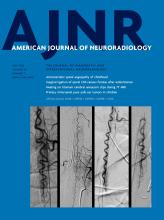Research ArticleBrain Tumor Imaging
Do We Need Gadolinium-Based Contrast Agents for Routine MRI Surveillance of Unoperated Pituitary Macroadenoma?
A.A. Alali, P.B. Hanagandi and P.J. Maralani
American Journal of Neuroradiology July 2022, 43 (7) 1024-1028; DOI: https://doi.org/10.3174/ajnr.A7554
A.A. Alali
aFrom the Division of Neuroradiology (A.A.A.), King Saud bin Abdulaziz University for Health Sciences, Riyadh, Saudi Arabia
P.B. Hanagandi
bDepartment of Medical Imaging (P.B.H.), King Abdulaziz Medical City NGHA, Riyadh, Saudi Arabia
P.J. Maralani
cDivision of Neuroradiology (P.J.M.), Department of Medical Imaging, University of Toronto, Sunnybrook Health Sciences Centre, Toronto, Ontario, Canada

References
- 1.↵
- Ezzat S,
- Asa SL,
- Couldwell WT, et al
- 2.↵
- 3.↵
- 4.↵Committee on Drugs and Contrast Media. ACR Manual on Contrast Media. 2021: American College of Radiology. 2021. https://www.acr.org/-/media/ACR/Files/Clinical-Resources/Contrast_Media.pdf.
- 5.↵
- 6.↵
- 7.↵
- Kanda T,
- Ishii K,
- Kawaguchi H, et al
- 8.↵
- 9.↵
- Quattrocchi CC,
- Mallio CA,
- Errante Y, et al
- 10.↵
- 11.↵
- Knosp E,
- Steiner E,
- Kitz K, et al
- 12.↵
- 13.↵
- Landis JR,
- Koch GG
- 14.↵
- 15.↵
- 16.↵
- Molitch ME
- 17.↵
- 18.↵
- Dekkers OM,
- Pereira AM,
- Romijn JA
- 19.↵
- 20.↵
- 21.↵
- Fahlbusch R,
- Honegger J,
- Buchfelder M
- 22.↵
- Powell M
- 23.↵
- Hisanaga S,
- Kakeda S,
- Yamamoto J, et al
- 24.↵
- Boto J,
- Guatta R,
- Fitsiori A, et al
- 25.↵
In this issue
American Journal of Neuroradiology
Vol. 43, Issue 7
1 Jul 2022
Advertisement
A.A. Alali, P.B. Hanagandi, P.J. Maralani
Do We Need Gadolinium-Based Contrast Agents for Routine MRI Surveillance of Unoperated Pituitary Macroadenoma?
American Journal of Neuroradiology Jul 2022, 43 (7) 1024-1028; DOI: 10.3174/ajnr.A7554
0 Responses
Jump to section
Related Articles
- No related articles found.
Cited By...
- No citing articles found.
This article has not yet been cited by articles in journals that are participating in Crossref Cited-by Linking.
More in this TOC Section
Similar Articles
Advertisement











